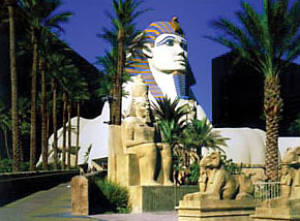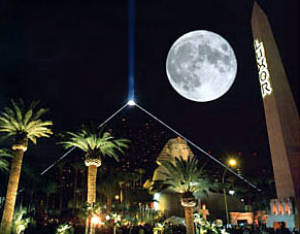|
Ancient Electricity |
|||||||
Learn the Truth about this amazing image here |
|||||||
|
The Baghdad Battery is the common name for a number
of artifacts
apparently discovered in the village of Khuyut
Rabbou'a (near Baghdad,
Iraq) in 1936. These artifacts came to wider attention
in 1938, when Wilhelm
König, the German director of the National Museum of
Iraq, found the
objects in the museum's collections, and (in 1940,
having returned to Berlin
due to illness) published a paper speculating that
they may have been galvanic
cells, perhaps used for electroplating gold onto
silver objects.
Description and Dating The artifacts consist of ~130 mm (~5 inch) tall terracotta jars (with a one and a half inch mouth) containing a copper cylinder made of a rolled-up copper sheet, which houses a single iron rod. At the top, the iron rod is isolated from the copper by asphalt plugs or stoppers, and both rod and cylinder fit snugly inside the opening of the jar which bulges outward towards the middle (reverse hourglass shape). The copper cylinder is not watertight, so when the jar was filled with a liquid, this would surround the iron rod as well. The artifact had been exposed to the weather and had suffered corrosion, although mild given the presence of an electrochemical couple. This has led some scholars to believe lemon juice, grape juice, or vinegar was used as an acidic agent to jumpstart the electrochemical reaction with the two metals. König thought the objects might be Parthian (between 250 BC and 224 AD) because the village where they were excavated was Parthian. However according to Dr. St. John Simpson of the Near Eastern department of the British Museum, their original excavation and context were not well recorded (see stratigraphy), so evidence for this date range is very weak. Furthermore, the style of the pottery (see typology) is Sassanid (224-640), so they are probably much more recent than König thought. Most of the components of the objects are not particularly amenable to advanced dating methods. The ceramic pots could be analysed by thermoluminescence dating, but this has apparently not yet been done; in any case, it would only date the firing of the pots, which is not necessarily the same as when the complete artifact was assembled. Another possibility would be ion diffusion analysis, which could indicate how long the objects were buried. Editors Note: It is surprizing to me that the available dating technique has not been applied. That it would "only date the firing of the pots" seems would at the very least give the date the pots were made, and would be a good start. What are they afraid of discovering? We already know they exist. At the very least this is positive, concrete evidence that SOME knowledge of electricity was known in Ancient Times. |
|||||||
|
. Electrical Copper and iron form an electrochemical couple, so that in the presence of any electrolyte, an electric potential (voltage) will be produced. König had observed a number of very fine silver objects from ancient Iraq which were plated with very thin layers of gold, and speculated that they were electroplated using batteries of these "cells". After the Second World War, Willard Gray demonstrated current production by a reconstruction of the inferred battery design when filled with grape juice. W. Jansen experimented with benzoquinone (some beetles produce quinones) and vinegar in a cell and got satisfactory performance. However, even among those who believe the artifacts were in fact electrical devices, electroplating as a use is not well regarded today. The gilded objects which König thought might be electroplated are now believed to have been fire-gilded (with mercury). Reproduction experiments of electroplating by Dr. Arne Eggebrecht consumed "many" reproduction cells to achieve a plated layer just one micrometre thick. Other scientists noted that Dr. Eggebrecht used a more efficient, modern electrolyte; using only vinegar, the "battery" is very feeble. An alternative, but still electrical explanation was offered by Paul Keyser. It was suggested that a priest or healer, using an iron spatula to compound a vinegar based potion in a copper vessel, may have felt an electrical tingle, and used the phenomenon either for electro-acupuncture, or to amaze supplicants by electrifying a metal statue. The Discovery Channel program MythBusters determined that it was indeed plausible for ancient peoples to have used the Baghdad Battery for electroplating or electrostimulation. However, the batteries which they reproduced did not produce a substantial amount of energy and had to be connected in series in order to test the myths. Editors Note: The assumption
made by most researchers
is that the only electrolytic solution they had back
then was lemon juice
or vinegar. As to needing more than one "battery" to
produce enough useful
voltage, most of our modern portable electronic
devices use that exact
same principle... multiple batteries connected in
series and many of these
are simple inserted against each other, not
connected by wire
|
|||||||
|
Some have claimed that these artifacts provide evidence of ancient knowledge of electricity, millennia before the conventional dates given for its discovery. However even if it is accepted that the "Baghdad batteries" were in fact electrical devices, this provides no evidence of any real knowledge of electrical phenomena. Any basic understanding of electrical theory of these cultures did not allow them to render more robust designs. The facts that using the electrodes in the electrolyte to produce the voltage, and using larger vessels gives a larger current is obvious to us today; but it is unclear if the ancient civilizations realised this. Whoever made the Baghdad batteries, assuming they were in fact galvanic cells, may not have fully understood the principles. For example, it is well known that the Ancient Greeks were aware of electrostatic electrical phenomena produced by amber, but they regarded it as a mere curiosity or toy and developed no electrical theory or functional devices. For evidence of ancient Parthian knowledge of the ideas of electricity, records of its use awaits discovery in more concrete terms, such as seeing it discussed in their writings (though they may not have stated it as 'electricity', relating instead a mystical connotation) or gaining a better perception that their "batteries" were designed with a knowledge of electrical theory. A controversy also exists as to whether the Ancient Egyptians could have used such devices. As electrical generators, the "Baghdad batteries" would be inefficient when compared to modern devices. However, if placed in appropriate network arrays, these artifacts could produce a qualitative power output. Luigi Galvani formulated a similar electrochemical couple experiment in the 1780s and, 20 years later, Alessandro Volta developed enough theory to convert Galvani's simple experiment into the efficient voltaic pile, producing around 30 volts of continuous current (but Volta's devices were much larger than known Baghdad relics). Within two or three more years Sir Humphry Davy was using voltaic piles that produced 1,000 volts and enough current to run an arc lamp. Editors Note: Scholars point to the lack of evidence found in ancient books and writings, yet tend to forget that the Ancient Library of Alexandria was burned to the ground with thousands of works lost forever from ancient scholars. As there are no known {or yet dicovered) other copies of these works, who knows what may have been in those works. It IS an important note though that once you have created the concept and developed it to a working model, generally it is only a short time to better understanding and more effective use as stated above. |
|||||||
|
Baghdad battery "myth" was put to the test. On Mythbusters' 29th episode (which aired on March 23, 2005), the Baghdad battery "myth" was put to the test. Ten hand-made terracotta jars were fitted to act as batteries. Lemon juice was chosen as the electrolyte to activate the electrochemical reaction between the copper and iron. (Oddly enough, it was discovered that a single lemon produced more voltage than one of the batteries). When all of the batteries were linked together, they produced upwards to 4 volts. Then, the major question was, “What were these ancient batteries used for?” The show’s research staff discovered three possible reasons: Electroplating, Medical pain relief (through Acupuncture), and Religious experience. It was discovered that the “linked” batteries indeed had sufficient power to electroplate a small token. For acupuncture, the batteries produced a “random” pulse that could be felt through the needles; however, it began to produce a painful burning sensation when the batteries were grounded to two needles at once. For the religious experience aspect of the batteries, a replica of the fabled Ark of the Covenant was constructed, complete with two angels. Instead of linking the angels’ golden wings to the low power batteries, an electric fence generator was connected. When touched, the wings produced a strong feeling of tightness in the chest. Although the batteries themselves had not been used, it was surmised that, due to the apparent lack of knowledge of electricity, any form of electrical sensation from them could equate to the “divine presence” in the eyes of ancient people. In the end, the Baghdad battery myth was found "plausible" on all three accounts. References * Dubpernell, G., "Evidence of
the use of primitive
batteries in antiquity". Selected Topics in the
History of Electrochemistry,
The Electrochemical Society, I-22 Princetn, NJ. 1978.
|
|||||||
"Let's hope the world manages to resolve its present problems so people can go and see them." - Dr Paul Craddock In 1940, Willard F.M. Gray, an engineer at the General Electric High Volatage Laboratory in Pittsfield, Massachusetts, read of Konig's theory. Using drawings and details supplied by German rocket scientist Willy Ley, Gray made a replica of the battery. Using copper sulfate solution, it generated about half a volt of electricity. In 1970s, German Egyptologist, Arne Eggebrecht built
a replica of
the Baghdad battery and filled it with freshly pressed
grape juice, as
he speculated the
This experiment proved that electric batteries were used some 1,800 years before their modern invention by Alessandro Volta in 1799. It also seems that the use of similar batteries can be safely placed into ancient Egypt, where several objects with traces of electroplated precious metals have been found at different locations. There are several anomalous finds from other regions, which suggests use of electricity on a grander scale. "It's a pity we have not found any wires," says Dr Craddock. "It means our interpretation of them could be completely wrong." But he is sure the objects are batteries and that there could be more of them to discover. "Other examples may exist that lie in museums elsewhere unrecognised". He says this is especially possible if any items are missing, as the objects only look like batteries when all the pieces are in place. SOURCE - BBC News - Thursday, 27 February, 2003 Editors Note: It seems to me that researches have overlooked something important. In regards to the lack of finding wires, it is not necessary for there to have been wires that were used to connect them, it could easily have been thin strips of copper of the same gauge used to make the cylinders inside the battery. Considering the conditions in which they were discovered, any strips of copper that may have been there originally could easily have been lost or misinterpreted, but its much more likely that after thousands of years unprotected thin copper would easily erode, or have been reused for other purposes over the years. Since y\this is an isolated discover at this point, it is too soon to tell. |
|||||||
|
Luxor Pyramid Las Vegas Nevada We have used the picture at the top of the page to illustrated the point that images alone cannot be conclusive without understanding the context. The picture is a genuine photo of the Luxor Hotel and Casino taken at dusk. The powerful beam emminating from the crystal peak can be seen from the moon, it is that powerful. The white "squiggles" you see in the beam are birds, bats, and large insects attracted by the light and photographed in time exposure. This, though pretty amazing view, is a common sight here in Las Vegas on any hot summer night. The pictures below are included because they are interesting views of our Great Pyramid here in Las Vegas. One thing is certain...THIS pyramid has lots of electricity.
|
|||||||
|
|
|||||||
| FAIR USE NOTICE: This page contains copyrighted material the use of which has not been specifically authorized by the copyright owner. Pegasus Research Consortium distributes this material without profit to those who have expressed a prior interest in receiving the included information for research and educational purposes. We believe this constitutes a fair use of any such copyrighted material as provided for in 17 U.S.C § 107. If you wish to use copyrighted material from this site for purposes of your own that go beyond fair use, you must obtain permission from the copyright owner. | |||||||
| ~ MENU ~ |









